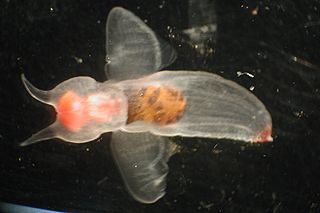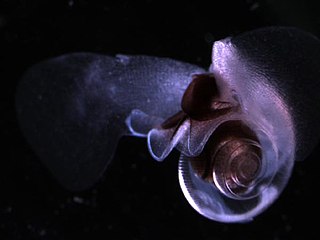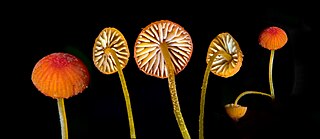
Sea angels are a large group of small free-swimming sea slugs, not to be confused with Cnidarians, classified into six different families. They are pelagic opisthobranchs in the clade Gymnosomata within the larger mollusc clade Heterobranchia. Sea angels were previously referred to as a type of pteropod.

Sea slug is a common name for some marine invertebrates with varying levels of resemblance to terrestrial slugs. Most creatures known as sea slugs are gastropods, i.e. they are sea snails that over evolutionary time have either completely lost their shells, or have seemingly lost their shells due to having a greatly reduced or internal shell. The name "sea slug" is most often applied to nudibranchs, as well as to a paraphyletic set of other marine gastropods without obvious shells.

Dolabrifera is a genus of sea hares, a taxonomic group of sea slugs or marine opisthobranch gastropod mollusks belonging to the family Aplysiidae.

Limacina is a genus of swimming predatory sea snails commonly known as sea butterflies in the family Limacinidae. This genus contains some of the world's most abundant gastropod species.

Pteropoda are specialized free-swimming pelagic sea snails and sea slugs, marine opisthobranch gastropods. Most live in the top 10 m of the ocean and are less than 1 cm long. The monophyly of Pteropoda is the subject of a lengthy debate; they have even been considered as paraphyletic with respect to cephalopods. Current consensus, guided by molecular studies, leans towards interpreting the group as monophyletic.

Dolabrifera dolabrifera is a species of sea hare, a marine gastropod mollusc in the family Aplysiidae, the sea hares. Dolabrifera dolabrifera, otherwise known as a Warty Seacat. The animal goes by many names, including the common sea hare. The Hawaiian name for Dolabrifera dolabrifera, is Kualakai.

Cecilioides acicula, common name the "blind snail" or "blind awlsnail", is a species of very small, air-breathing land snail, a terrestrial pulmonate gastropod mollusk in the family Ferussaciidae.

The family Cavoliniidae is a taxonomic group of small floating sea snails, pelagic marine opisthobranch gastropod mollusks.
Clione limacina, known as the naked sea butterfly, sea angel, and common clione, is a sea angel found from the surface to greater than 500 m (1,600 ft) depth. It lives in the Arctic Ocean and cold regions of the North Atlantic Ocean. It was first described by Friderich Martens in 1676 and became the first gymnosomatous "pteropod" to be described.

Mycena acicula, commonly known as the orange bonnet, or the coral spring Mycena, is a species of fungus in the family Mycenaceae. It is found in Asia, the Caribbean, North America and Europe. The fruit bodies, or mushrooms, of the fungus grow on dead twigs and other woody debris of forest floors, especially along streams and other wet places. They have small orange-red caps, up to 1 cm (0.4 in) in diameter, held by slender yellowish stems up to 6 cm (2.4 in) long. The gills are pale yellow with a whitish edge. Several other Mycena species look similar, but may be distinguished by differences in size and/or microscopic characteristics. M. acicula is considered inedible because of its small size.

Limacina helicina is a species of small swimming planktonic sea snail in the family Limacinidae, which belong to the group commonly known as sea butterflies (Thecosomata).

Eulimella acicula is a species of sea snail, a marine gastropod mollusk in the family Pyramidellidae, the pyrams and their allies.

Sander Rang or Paul Charles Leonard Alexander Rang was a French conchologist and interpreter of Arabic texts. He was, in 1816, one of the survivors of the sinking of the frigate Medusa, on which he was an ensign. He spent a good part of his life in La Rochelle, where he published his early zoological observations, in particular in the bulletins of the Society of Natural Sciences of Charente-Maritimes.In 1841 Rang was one of the founding members of the Société des Amis des Arts now the Musée des Beaux-Arts de La Rochelle.He specialised in marine fauna notably in sea hares, cephalopods and other molluscs and on the heterogenous group known as zoophytes. Sander Rang described many new mollusc species including the sea hares Aplysia dactylomela, Dolabrifera dolabrifera, the cuttlefish Sepia hierredda and the land snails Striosubulina striatella, Pleurodonte desidens and Opeas hannense.

The family Hyalocylidae is a taxonomic group of small floating sea snails, pelagic marine opisthobranch gastropod mollusks.
Creseis is a genus of gastropods belonging to the family Creseidae.
Spongiobranchaea australis is a species of sea angel, a form of sea-slug plankton. It has a partially transparent body with small "wings" that it uses to swim in its habitat. It is classified as a pteropod.
Hyalocylis striata is a species of Hyalocylis, a pteropod. It is a gastropod mollusk.
Cuvierina atlantica is a species of sea mollusk, commonly known as a sea-angel pteropod.
Diacavolinia longirostris is a species of sea butterfly. It is a pteropod.










